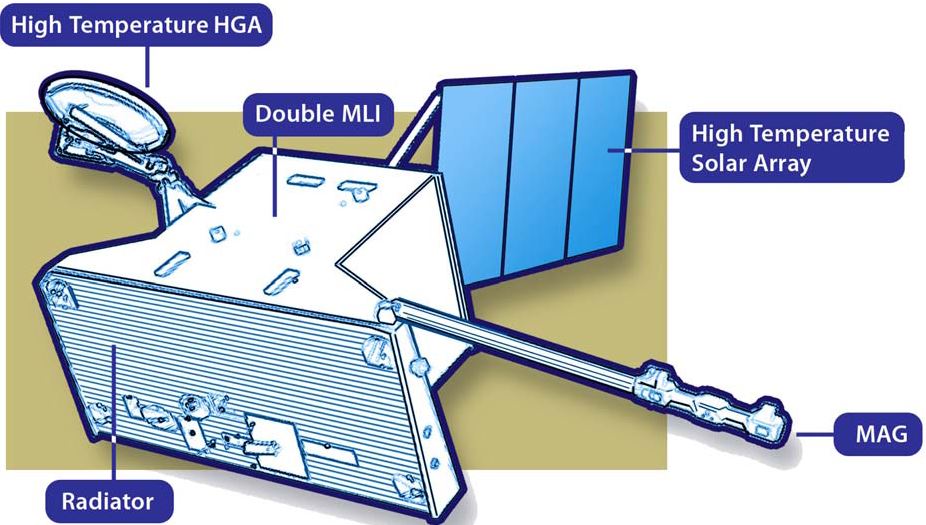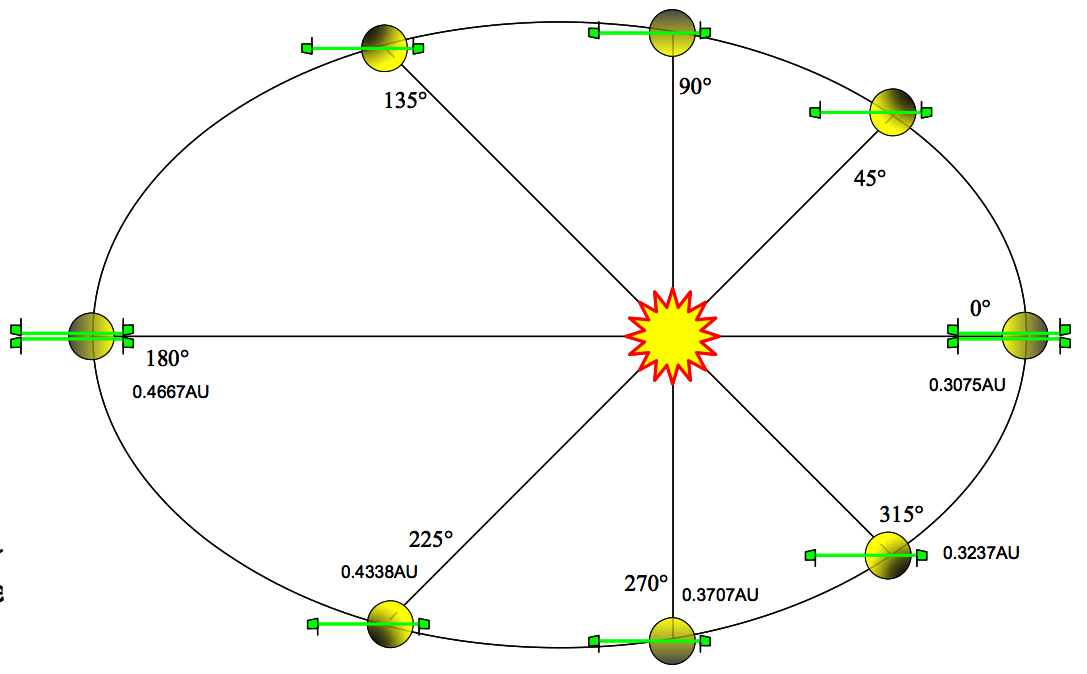Mercury Planetary Orbiter (MPO) - BepiColombo
Mercury Planetary Orbiter
The Mercury Planetary Orbiter (MPO) is a three-axis stabilised spacecraft which will orbit Mercury in an inertial polar orbit of 2.3h period. It accommodates 11 instruments or instrument suites and has a box-like shape of 3.9 x 2.2 x 1.7 m.
The radiator, on the -Y side, will always face away from the Sun (the MPO will flip by 180º at perihelion and aphelion, meaning both -X and +X sides will face in the ram direction), and most of the instruments are on the -Z side, which will nominally always face towards Mercury (i.e. nadir). The altitude range is expected to be 480 km to 1500 km, with the latitude of the periherm varying between 16ºN to 16ºS over the course of the nominal science phase (i.e. the first full Earth year).

As can be seen in the orbit figure below, at perihelion, the MPO's apoherm is on the dayside - this configuration minimises the thermal load, both from the Sun and from Mercury's albedo. The perihelion is an important time for the exospheric instruments; at perihelion the planet's spin speed is slightly overtaken by the orbit speed, and from the surface the Sun would appear to slow down, stop, go in the other direction for ~4 (Earth) days, then slow, stop and continue in the ‘correct' direction - the dawn and dusk effectively swap.
The aphelion time is the most important for the cameras and surface scanning instruments, while the periherm is in the dayside, i.e. the surface is lit and close so that the cameras can get good resolution.

Diagram describing schematically how the periherm and apoherm vary throughout the Mercury year.
The spacecraft
Star Trackers, Thrusters and Reaction Wheels
Four redundant 22N thrusters in the nadir face to be used in orbital manoeuvres until final orbit acquisition, after which they will be deactivated. The control of the attitude is provided by a set of four reaction wheels and four 10N thrusters for momentum wheel de-saturation; these thrusters are mounted on the radiator. Three star trackers, also mounted on the radiator side, sun sensors and a high precision gyroscope package are employed as sensors for attitude control, the combination of which provides precise attitude determination required by several of the instruments.
Radiator
The only side of the spacecraft not to see the Sun is the radiator; highly reflective fins (polished and geometrically reflecting outwards) have been mounted to it at an appropriate angle, to minimize absorption of heat radiated from Mercury, and to allow radiation towards deep space.
Solar Array
Because of the intense heat, the three-panel solar array is a 70-30% mixture of solar cells and Optical Surface Reflectors (OSR, i.e. mirrors) to keep its temperature below 200°C. This is supported by choosing sun incident angles up to 80° that generate enough power, but do not unnecessarily heat up the solar array. There is a battery and heaters that operate in the freezing dark during eclipse.
Overview of the instruments
- BELA - BepiColombo Laser Altimeter
- ISA - Italian Spring Accelerometer
- MERMAG - MPO-Magnetometer (MERMAG includes the magnetometer on the MMO)
- MERTIS - Mercury Radiometer and Thermal Infrared Spectrometer
- MGNS - Mercury Gamma-Ray and Neutron Spectrometer
- MIXS - Mercury Imaging X-Ray Spectrometer
- MORE - Mercury Orbiter Radio-Science Experiment
- PHEBUS - Probing of Herman Exosphere by Ultraviolet Spectroscopy
- SERENA - Search for Exospheric Refilling and Emitter Natural Abundances
- SIMBIO-SYS - Spectrometer and Imagers for MPO BepiColombo Integrated Observatory System
- SIXS - Solar Intensity X-Ray and Particles Spectrometer
There are two extendable booms, one of 2.8m for the dual magnetometer (inboard sensor is mounted at 80cm from the end and the outboard on the end of the boom) and another for the MGA.

